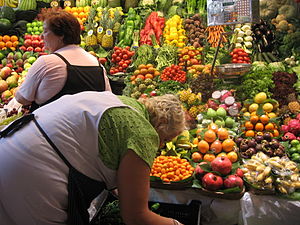| Environmental contamination with pesticides (Photo credit: Wikipedia) |
#1. Check your food’s mileage. Many foods come from half way around the world to land on your kitchen table. That means that they’re often harvested early (and green), robbing you of nutrients. It also means that to make the trip they are filled with preservatives and pesticides to maximize productivity and enhance longevity. To find out where a food comes from, simply check the label. It will say, "Grown and raised in Iowa" or "California oranges", or "Farm-raised in Thailand" and so on.
Buying food that comes from just down the street, or at least within your home state, accomplishes two things. It helps to ensure you’re not receiving nutrient-poor foods or foods heavily loaded with toxins. It also reduces the carbon footprint and helps the environment.
#2. Buy according to what is in season. Buying strawberries in December is definitely going to cost you more in terms of carbon footprint and money than buying them in June or July (at least in most areas of the world).
#3. Buy fruits and vegetables locally. Buy your fruits and vegetables from local organic farmers who can charge much less for their produce because they don’t have to pay for distribution. Additionally, you’re helping to sustain your local economy and you’re ensuring that thousands of gallons in fuel are not required to get the produce from the farm to your table.
| Organic, locally grown food at a farm market. (Photo credit: Wikipedia) |
#4. Try growing a few fruits and veggies on your own. Whether you live in a small space or you have acres of land, you can grow your own herbs, fruits and vegetables. This not only provides immense satisfaction, it saves you money and is good for the sustainability of our planet. (See our sustainable gardening blog for tips and helpful resources on starting your own garden, or visit www.newholisticliving.com/sustainablegardening.html.)
#5. Finally, whenever possible, buy organic. Organic farmers treat your food and the planet with more respect. Unlike industrialized farms, they do not use chemical pesticides, fungicides or fertilizers. They use sustainable practices to keep you and our planet healthy.
Knowing where your food comes from is important for the planet, but it’s also important for your own health and the health of your family. Pay attention and take measures to buy your food from sustainable resources. You’ll be glad you did.
Learn More About Your Food:













